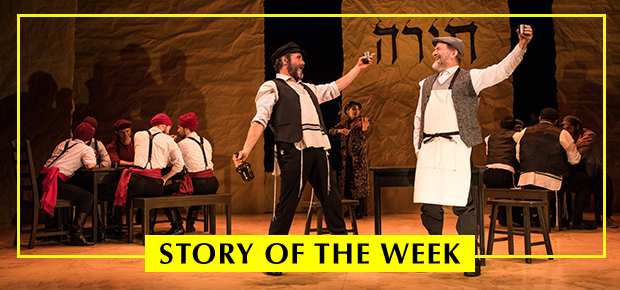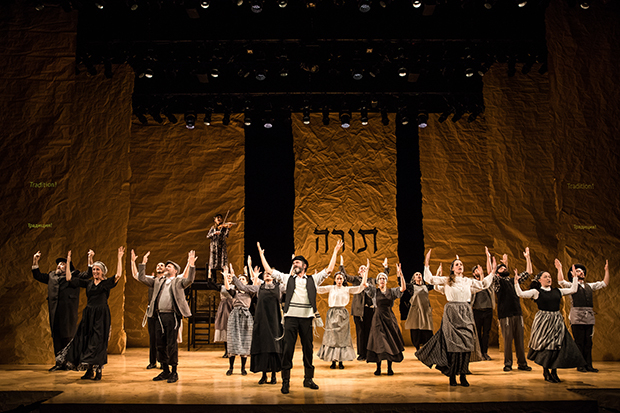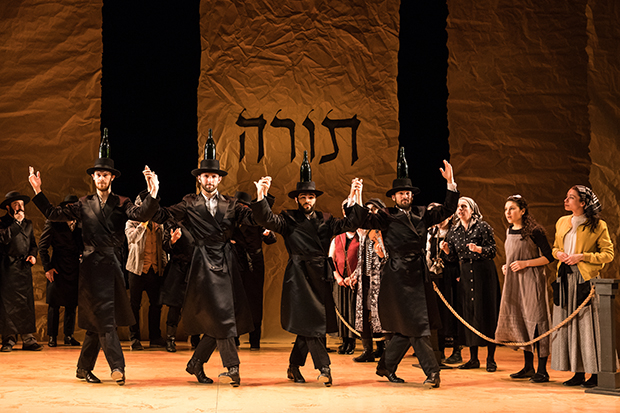Why Did Fiddler on the Roof in Yiddish Succeed?
How an unorthodox revival of a classic musical managed to stay afloat for nearly a year in the perilous waters of commercial off-Broadway.

(© Matthew Murphy)
New York audiences have until January 5 to see the acclaimed Yiddish-language revival of Fiddler on the Roof. The production announced this week that it was ending its 11-month run at off-Broadway's Stage 42. When it closes in January, it will have played 375 performances (including 12 previews), the longest run ever at the theater (the previous record-holder, Trip of Love, played 335 performances).
While Trip of Love was roundly panned, A Fidler afn Dakh (its Yiddish title) was universally praised by critics and audiences alike — a rare achievement for commercial off-Broadway, especially for a musical performed in a language few in the audience can fully comprehend without the help of supertitles.
This Story of the Week will recount the history of the production, explain why it was so successful, and look to what's next.

(© Matthew Murphy)
How did the Yiddish revival of Fiddler on the Roof come about?
The production was originally announced as part of the 2018 summer season for the National Yiddish Theatre Folksbiene. As America's premier Yiddish theater, NYTF performs all of its shows in that language, traditionally spoken by Central European Jews. It was the language used by writer Sholem Alecheim, whose short stories provide the basis for Fiddler on the Roof. So a production of the musical in Yiddish is a natural fit.
Fiddler is about the tension between tradition and modernity within one family living in the Jewish shtetl of Anatevka. It features a book by Joseph Stein, music by Jerry Bock, and lyrics by Sheldon Harnick. This revival used the Yiddish translation (by Shraga Friedman) that was used in the 1965 Israeli debut. The limited run was originally announced for July 4-August 12, 2018, at the Museum of Jewish Heritage, and was subsequently extended to August 26, then September 2, then October 25, then November 18, and finally, December 30.

(© Victor Nechay)
Why did it keep extending?
The production clearly struck a chord with audiences, and I think there are a few reasons why. First, it's Fiddler, which is close to perfection, as far as musicals go. "Tradition," "If I Were a Rich Man," "To Life," "Sunrise, Sunset"…every song is a winner. And what could be more quintessentially 20th-century American than a story of children pushing against the rules and traditions handed down to them (and parents reevaluating those ideas in turn)? Fiddler is a great show even in mediocre productions, and it has a dedicated audience in New York: It has been revived on Broadway five times since its 1964 debut, with the last two running over a year.
But when it comes to revivals, it helps to approach the show with a perspective, rather than faithfully restaging a show everyone already knows. This latest revival features a pared-down production from director Joel Grey (yes, that Joel Grey). The central feature of Beowulf Boritt's set is a large sheet of brown paper with the Hebrew word for Torah written on it. When that sheet is torn during the first act pogrom, the effect is devastating, consistently evoking gasps from the audience. The simplicity of the design allows audiences to focus on the excellent performances, music, and words — which are, of course, all in Yiddish.
This last element is the most notable element of the production, and certainly what it will be remembered for. But producing an American musical in the language of the source material isn't just a clever gimmick: It seems to unlock deep memories for Jewish viewers. At both of the performances I attended, audience members told me that words were jumping out at them that they hadn't heard since they were little kids listening to Jewish parents and grandparents kibitz. A few also told me that it was encouraging to hear this language, which has been so diminished by the Holocaust and diaspora assimilation, spoken in a giant theater in New York City. That's another sign of a great show: It makes you want to talk about it to complete strangers during intermission.
When did it move to 42nd Street?
The runaway success of Fiddler at the Museum of Jewish Heritage led to an uptown transfer to Stage 42 (which is, appropriately, on 42nd Street). Previews began February 11, 2019, with an official opening on February 21. At 499 seats, Stage 42 (formerly known as the "Little Shubert") is the largest commercial off-Broadway house (500 seats is the minimum capacity for a theater to be considered "Broadway," a distinction that is also wrapped up in location and union contracts). It is also famously difficult to fill.
"It's cursed," said a casting director to Steven Skybell (who plays Tevye) when he shared that the production was moving there. Skybell was optimistic that Fiddler was the show to break the curse, and in many ways it has: The show has become one of the most loved attractions off-Broadway, and as I mentioned before, it is now the longest-running show ever at Stage 42. But some sort of dybbuk still clings to that troublesome theater.
Hard as it is to believe, after a nearly yearlong run at Stage 42, Fiddler has failed to recoup its $2.6 million investment (modest by Broadway standards, where big musicals regularly run into the tens of millions). This underlines just how difficult it is to produce commercially off-Broadway. Beyond a handful of performance art spectacles and vanity projects, shows don't stick around long enough to recoup a multimillion-dollar investment — not like on Broadway, where decades-long runs of shows like The Phantom of the Opera and Chicago have made some investors rich.

(© Matthew Murphy)
What's next?
According to the New York Times, the producers of Fiddler are still hoping to recoup through national and international tours. The first of those will be in Australia next year: Under the banner of Opera Australia, A Fidler afn Dakh will play the Sydney Opera House from September 10-October 31, 2020. It then moves to Melbourne's Comedy Theatre (November 15-December 20).
For those who can't make it Down Under, the cast recording from the New York production is available on Spotify and Amazon. I have not yet heard about plans for this script to be licensed for amateur and stock productions through Musical Theatre International (which handles the license for the English version), but I have to imagine there are a few high school drama teachers out there ambitious enough to put their students through Yiddish immersion.
Until then, you can still catch A Fidler afn Dakh on 42nd Street through the end of 2019. L'Chaim!








